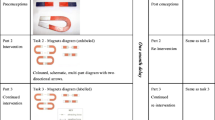Abstract
Understanding science involves the mastery of complex networks of concepts. To design effective computer based systems for learning science it is essential to adequately characterize the nature of those conceptual networks, so that clear and appropriate instructional goals can be defined and fed into the design process. This paper considers a novel class of representations for science instruction — Law Encoding Diagrams (LEDs) — and describes the nature of scientific understanding based on these representations. A framework of four classes of schemas has been proposed to characterizes problem solving and learning with LEDs. How the framework encompasses complex networks of concepts is discussed and the implications for the design of computer based learning environments based on LEDs are considered.
Résumé
La compréhension scientifique implique la maîtrise de réseaux complexes de concepts. Pour préparer des systèmes informatiques de base efficaces pour apprendre les sciences il est essentiel de caractériser de façon adéquate la nature de ces réseaux de concepts, de telle sorte que des buts didactiques clairs et appropriés puissent être définis et introduits dans la conception du projet. L’article examine une nouvelle classe de représentations pour l’enseignement scientifique — Law Encoding Diagrams (LEDs) — et décrit la nature d’une compréhension scientifique basée sur ces représentations. Un ensemble structuré de quatre classes de schémas a été proposé pour caractériser la résolution de problèmes et l’apprentissage avec LEDs. La discussion porte sur les réseaux complexes de concepts inhérents à ce cadre de et on en examine les implications pour la conceptions d’environnements d’apprentisages informatisés basés sur LEDs.
Similar content being viewed by others
References
Cheng, P.C-H. (1993). Multiple interactive structural representation systems for education. In R. Cox, M. Petre, P. Brna, & J. Lee (Eds.),Proceedings of the Workshop of Graphical Representations, Reasoning and Communication of the AI-ED 93 World Conference on Artificial Intelligence in Education (pp. 25–28). Edinburgh: University of Edinburgh.
Cheng, P.C-H. (1996a). Scientific discovery with law encoding diagrams.Creativity Research Journal, 9, 145–162.
Cheng, P.C-H. (1996b). Law encoding diagrams for instructional systems.Journal of Artificial Intelligence in Education, 7, 33–74.
Cheng, P.C-H. (1996c). Learning qualitative relations in physics with law encoding diagrams. In G.W. Cottrell (Ed.),Proceeding of the Eighteenth Annual Conference of the Cognitive Science Society (pp. 512–517). Hillsdale, NJ: Lawrence Erlbaum.
Cheng, P.C-H. (1997). Components of a cognitive theory of problem solving and discovery with law encoding diagrams. In M. Anderson (Ed.),AAAI Fall Symposium: Reasoning with Diagrammatic Representations II (pp. 85–93). Cambridge, MA: AAAI.
Cheng, P.C-H. (1998). A framework for scientific reasoning with law encoding diagrams: Analysing protocols to assess its utility. In M.A. Gernsbacher & S.J. Derry (Eds.),Proceedings of the Twentieth Annual Conference of the Cognitive Science Society (pp. 232–235). Hillsdale, NJ: Lawrence Erlbaum.
Cheng, P.C-H., & Simon, H.A. (1992). The right representation for discovery: Finding the conservation of momentum. In D. Sleeman & P. Edwards (Eds.),Machine Learning: Proceedings of the Ninth International Conference (ML92) (pp. 62–71). San Mateo, CA: Morgan Kaufmann.
Cheng, P.C-H., & Simon, H.A. (1995). Scientific Discovery and Creative Reasoning with Diagrams. In S. Smith, T. Ward, & R. Finke (Eds.),The Creative Cognition Approach (pp. 205–228). Cambridge, MA: MIT Press.
Chi, M.T.H., Feltovich, P.J., & Glaser, R. (1981). Categorization and representation of physics problems by experts and novices.Cognitive Science, 5, 121–152.
Ellis, H.C., & Hunt, R.R. (1993). Fundamentals of Cognitive Psychology (5th ed.). Madison, WI: Brown and Benchmark.
Giere, R.N. (1994). The cognitive structures of scientific theories.Philosophy of Science, 61, 276–296.
Kaput, J.J. (1992). Technology and Mathematics Education. In D.A. Grouws (Eds.),Handbook of Research on Mathematics Teaching and Learning (pp. 515–556). New York, NY: MacMillan.
Kindfield, A.C.H. (1994). Biology diagrams: Tools to think with.Journal of the Learning Sciences, 3, 1–36.
Koedinger, K.R., & Anderson, J.R. (1990). Abstract planning and perceptual chunks: Elements of expertise in geometry.Cognitive Science, 14, 511–550.
Langley, P., Simon, H.A., Bradshaw, G.L., & Zytkow, J.M. (1987).Scientific Discovery: Computation Explorations of the Creative Processes. Cambridge, MA: MIT Press.
Larkin, J.H., McDermott, J., Simon, D.P., & Simon, H.A. (1980). Models of competence in solving physics problems.Cognitive Science, 4, 317–345.
Larkin, J.H., & Simon, H.A. (1987). Why a diagram is (sometimes) worth ten thousand words.Cognitive Science, 11, 65–99.
Michener, E.R. (1978). Understanding understanding mathematics.Cognitive Science, 2, 361–383.
Reif (1987). Interpretation of scientific or mathematical concepts: Cognitive issues and instructional implications.Cognitive Science, 11, 395–416.
Stenning, K., & Oberlander, J. (1995). A cognitive theory of graphical and linguistic reasoning: Logic and implementation.Cognitive Science, 19, 97–140.
White, B. (1989). The role of intermediate abstractions in understanding science and mathematics. In Proceedingsof the Eleventh Annual Meeting of the Cognitive Science Society (pp. 972–979). Hillsdale, NJ: Lawrence Erlbaum Associates.
White, B., & Frederiksen, J. (1990). Causal model progressions as a foundation for intelligent learning environments.Artificial Intelligence, 24, 99–157.
Author information
Authors and Affiliations
Corresponding author
Additional information
This work was supported by the U.K. Economic and Social Research Council through the Centre for Research in Development, Instruction and Training.
Rights and permissions
About this article
Cite this article
Cheng, P.CH. Networks of law encoding diagrams for understanding science. Eur J Psychol Educ 14, 167–184 (1999). https://doi.org/10.1007/BF03172964
Received:
Issue Date:
DOI: https://doi.org/10.1007/BF03172964




